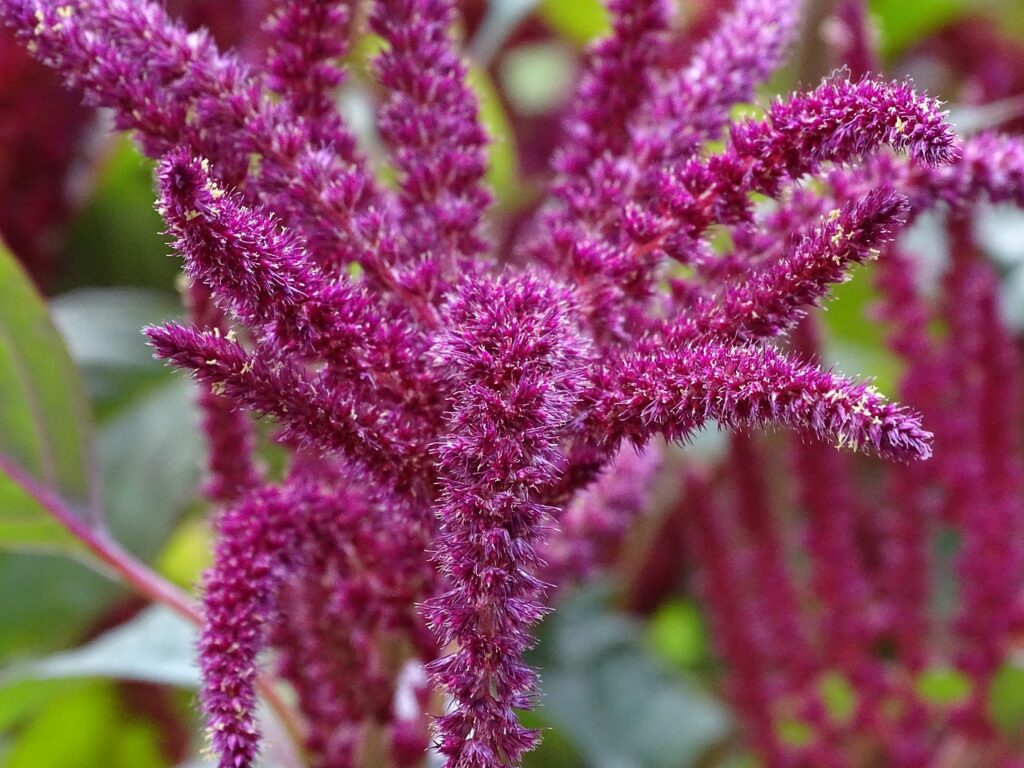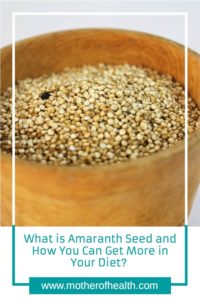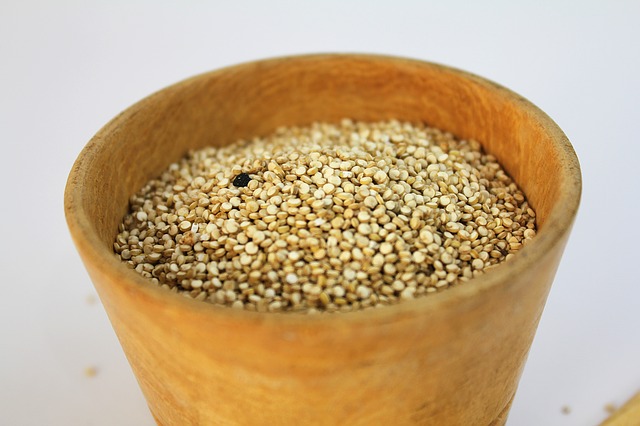Much like every other grain in the market that comes with the sellers’ promise of health, Amaranth has taken its place on the long list of healthy foods. In this article we take a closer look at the amazing health benefits of Amaranth,
It is not a surprise that Amaranth has been an actively used ingredient for six thousand to eight thousand years in Peru and the Yucatan peninsula.
But what is Amaranth Seed exactly?
What is Amaranth Seed?
Botanically, it is not actually a grain. It is what scientists refer to as a pseudo-cereal; a seed.
Amaranth seeds come from a rather tall plant, about six feet in height with broad leaves. The flowers blossom in hues of red and golden yellow and are spread over 60 different species.
It has been named after the word ”Amarantos”, referring to one that does not wither. It is well known by the names of Rajgira and Ramdana in Hindi and Amar in Sanskrit.
Where it's grown and cultivated
Nutrition:
- Calories: 251
- Iron: 29%
- Manganese: 105%
- Magnesium: 40%
- Vitamin C: 15%
- Iron: 29%
- Copper: 18%
- Selenium: 19%
- Dietary fiber: 52%
- Vitamin C: 15%
- Calcium: 31%

Health Benefits Of Amaranth
Amaranth, also known as Rajgira on the down low, is a health junkie’s power food. Not just that, the incredible resume of health benefits it possesses puts it under the category of superfoods. Some salient features of the friendly neighborhood Amaranth are:
1. Great For Gluten Intolerant People

First and foremost, it is completely gluten-free in nature. Instead of having to rely upon removing gluten from wheat and other grains, amaranth can be utilized as an easier and more approachable alternative and possibly the major source of gluten-free flour and grain of the future.
2. Great Source of Protein
It might be a tiny little seed, but it sure packs in all the nutritional needs that your body demands. With a protein content of approximately 26 grams per cup, it beats the protein content of most grains used as staples.
It contains Lysine, an amino acid rarely found elsewhere. Amaranth contains a very high composition of all essential amino acids and hence, classifies itself as a complete protein.
3. Effective For People Susceptible To Cardiovascular Diseases
It is a very fibrous crop and has produced significant results in preventing heart ailments and digestive issues while simultaneously fighting any pre-existing conditions. It is best advised to include it as a part of your daily diet.
4. Great For Bones
Amaranth is not only a great source of protein and fiber but also manganese, magnesium, phosphorus, and iron. It helps keep your digestive system regulated, builds your strength, and reduces the risk of fracture or broken bones.
5. It Curbs Inflammation In The Body
It also possesses antioxidant and anti-inflammatory effects. It is being used to prepare medicines designed to provide antioxidants and combat inflammatory conditions.
6. Great For Weight Loss & Weight Gain
Being a complete protein crop, it is useful to promote healthy weight gain for those seeking it through muscle growth and also aiding in weight loss as it is a low-calorie food source.
The high fiber content helps in regular bowel movements and maintaining a good digestive system, which is necessary for any weight loss regime. It is also known to reduce high blood cholesterol.
Not only that, but the protein content also helps in building neurological function and aiding in digestion, and maintaining optimal hormonal balance.
7. Used as a Medicine
It has multiple applications when it comes to health. It is used in medicines, as a food source, and for treatments and therapy. Amaranth leaves are used to make medicines, while flour and grains are used for food. Amaranth oil is used for topical treatments and also for regular skincare.
8. Used For Detox
It is a great detoxifier. When toxins reach excess levels in one’s body, it can cause severe long-term damage and is normally accompanied by high levels of inflammation in tissues and other areas.
9. Completes Folate Deficiency
It not only acts as a general-purpose blessing in the name of food or medicine but also as a specific target. The folate in the grain helps the body make new cells. For pregnant women, a folate deficiency can lead to neural tube defects. A deficiency can also cause defects such as heart and limb malformations. Amaranth is the solution for healthy folate intake.
10. Can be helpful in Diabetes Control
It has been known to control diabetes. A study published in January 2018, shows an increase in insulin secretion in Goto-Kakizaki rats suffering from Type II Diabetes.
11. Alleviates Hypertension
Regular use of Amaranth is found to increase unsaturated fatty acids in the body, which reduces the risk of heart failure, high blood pressure, rheumatoid arthritis, and obesity.
The grain contains tocotrienols and squalene compounds, which affect cholesterol biosynthesis. It lowers blood cholesterol levels by improving the body’s efficiency of cholesterol absorption.
Some Less Known Facts About Amaranth
Amaranth is a fighter:
It does prefer a high elevation when it comes to cultivation but will make you happy regardless if it has moist and loose soil with a good drainage capacity. And once well-grown and firm in the soil, the Amaranth plant will reward you with its survival capacity even when there is less water.
The seed isn’t the only edible part of the plant:
Amaranth is a highly versatile crop. It can be used and consumed in many forms. The leaves of the amaranth plant are just as nutritious in nature and fit well into the diet that you desire to follow. You can cultivate it easily. You can add it to absolutely any dish.
The leaves, grain, flour, and oil can be easily procured from the market and used as per your desired objective.

How To Incorporate Amaranth In Your Daily Diet?
Amaranthus is quite a versatile ingredient when it comes to cooking. It is not only kind to the experienced cook but also to the fitness freaks that just want the next dose of nutrition. However, it must be noted that it is on the heavier side. It is advisable to mix it into an equivalent quantity of another base, for instance, quinoa.
1. Adding it into the dessert:
It is a perfectly healthy addition to those cheat day meals and makes you feel good without gaining those extra pounds. It is your best friend when it comes to fighting weight gain.
Just swap a portion of oats or wheat and maybe even that rice that you wanted in your kheer(porridge) and enjoy a wonderful teaspoon. I mean, tablespoon. Teaspoons aren’t for cheat days or cheesecake. Speaking of cheesecake, add a nice touch by sprinkling some amaranth seed powder over that cheesecake for that extra bit of nuttiness.
2. Salads:
You can swap quinoa for Amaranth. Packed with proteins and essential amino acids, it gives you all that you need in a regular portion. Should you find the salad to be on the heavier side, you may swap a portion of your favorite grain with the seeds.
3. Popcorn, anyone?
You can make popcorn with this grain. Gone are the days that needed a handful of corn kernels in a generic glass bowl to Netflix and chill. Amaranth can be popped and swapped with corn kernels.
So go ahead! Include this fine seed into all that you love. Experiment, swap, and cherish this superfood on your path to wellness!


Swati Rawat is an Ayurveda enthusiast & blogger at honeyfurforher.com. She loves to read and share her knowledge of healthy living. My mission is to make people discover the beauty of Ayurvedic sciences and help then incorporate it in their daily lives.


